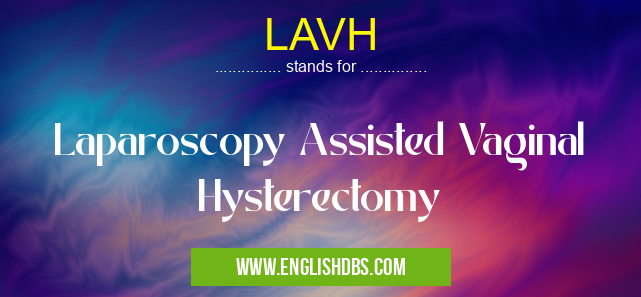What does LAVH mean in UNCLASSIFIED
LAVH (Laparoscopy-Assisted Vaginal Hysterectomy) is a minimally invasive surgical procedure used to remove the uterus through the vagina with the assistance of laparoscopic instruments. This technique offers several advantages over traditional open hysterectomy, including reduced pain, shorter recovery time, and less scarring.

LAVH meaning in Unclassified in Miscellaneous
LAVH mostly used in an acronym Unclassified in Category Miscellaneous that means Laparoscopy Assisted Vaginal Hysterectomy
Shorthand: LAVH,
Full Form: Laparoscopy Assisted Vaginal Hysterectomy
For more information of "Laparoscopy Assisted Vaginal Hysterectomy", see the section below.
What is LAVH?
LAVH combines the techniques of laparoscopy and vaginal hysterectomy. During laparoscopy, small incisions are made in the abdomen, and a laparoscope (a thin tube with a camera) is inserted to visualize the pelvic organs. Through these incisions, surgical instruments are introduced to detach the uterus from its supporting structures. Once the uterus is freed, it is removed through the vagina.
Advantages of LAVH
- Reduced pain: Laparoscopic incisions are smaller than those made in open surgery, resulting in less postoperative pain.
- Shorter recovery time: LAVH typically requires a shorter hospital stay and recovery period compared to open hysterectomy.
- Less scarring: Laparoscopic incisions are less visible than open surgery scars.
- Preservation of the ovaries: In most cases, LAVH allows for the preservation of the ovaries, which helps maintain hormonal balance.
- Lower risk of infection: Laparoscopic surgery carries a lower risk of infection compared to open surgery.
Indications for LAVH
LAVH is commonly used to treat:
- Uterine fibroids: Benign growths in the uterine wall.
- Endometriosis: Displacement of endometrial tissue outside the uterus.
- Pelvic organ prolapse: Descent of the uterus or other pelvic organs.
- Uterine abnormalities: Such as uterine malformations or adenomyosis.
Procedure of LAVH
- Preparation: The patient is given general anesthesia and placed in the lithotomy position.
- Laparoscopy: Small incisions are made in the abdomen, and a laparoscope is inserted to visualize the pelvic organs.
- Uterine detachment: Laparoscopic instruments are used to detach the uterus from its supporting structures.
- Vaginal entry: An incision is made in the vagina to allow for the removal of the uterus.
- Uterine removal: The uterus is gently pulled out through the vagina.
- Closure: The vaginal and laparoscopic incisions are closed with stitches or staples.
Essential Questions and Answers on Laparoscopy Assisted Vaginal Hysterectomy in "MISCELLANEOUS»UNFILED"
What is a Laparoscopy Assisted Vaginal Hysterectomy (LAVH)?
A LAVH is a surgical procedure to remove the uterus (womb) through the vagina with the assistance of laparoscopy. Laparoscopy involves making small incisions in the abdomen and inserting a camera and surgical instruments to visualize and remove the uterus.
Why is a LAVH performed?
LAVH is performed to treat various conditions, including:
- Uterine fibroids
- Endometriosis
- Pelvic organ prolapse
- Uterine cancer
- Abnormal uterine bleeding
What are the advantages of LAVH?
LAVH offers several advantages over traditional abdominal hysterectomy, including:
- Less pain and discomfort
- Smaller incisions
- Shorter recovery time
- Reduced risk of complications
How is a LAVH performed?
LAVH is performed under general anesthesia. The surgeon makes several small incisions in the abdomen and inserts a laparoscope and surgical instruments. The uterus is then detached from surrounding tissues and removed through the vagina.
What is the recovery time for a LAVH?
The recovery time for LAVH varies but typically takes 2-4 weeks. Most patients can return to normal activities within a few days but should avoid strenuous activity for several weeks.
What are the potential complications of LAVH?
Like any surgery, LAVH carries potential complications, including:
- Infection
- Bleeding
- Blood clots
- Damage to surrounding organs
- Hernia
Who is a good candidate for LAVH?
LAVH is suitable for women with a uterus that is not too large or enlarged, or who have no other medical conditions that would make the procedure more difficult or risky. Your doctor will assess your individual circumstances to determine if LAVH is the best option for you.
Final Words: LAVH is a safe and effective surgical option for various uterine conditions. It offers significant advantages over traditional open hysterectomy, including reduced pain, shorter recovery time, and less scarring. Women considering a hysterectomy should discuss LAVH with their healthcare provider to determine if it is the right option for them.
